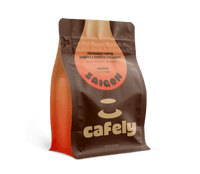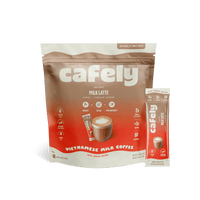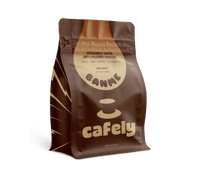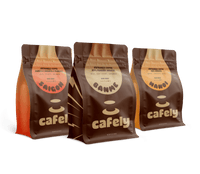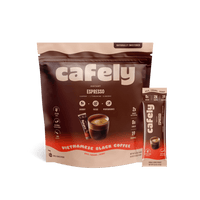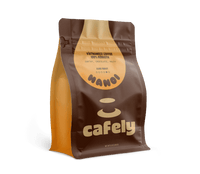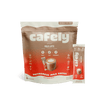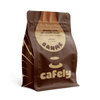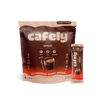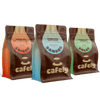Coffee contains a cocktail of different compounds that mingle together to provide the final flavor. Some of these compounds have a strong acidic taste; others are sweet or bitter.
High acidity levels in coffee aren’t necessarily an indication of poor quality — some of the highest-grade coffees in the world have plenty of acidity.
However, the ideal flavor of coffee comes down to the individual — if you find some coffees aggravate your gastric reflux, it's wise to look for coffees with a less acidic nature.
Here, we'll explore everything you need to know to find low-acid coffee and how you can brew it to further minimize triggering the uncomfortable burn of acid reflux.
Top Recommendations:
- Instant Vietnamese Black Coffee — Naturally low in acidity, making it more gentle on the stomach than typical coffees.
- BanMe Coffee— A robusta blend with notes of cherry, chocolate, and spices, especially roasted to reduce acidity.
- SaiGon OG — Strong and flavorful with a low-acid profile, ideal for a rich coffee experience without reflux issues.
- DaLat Coffee — 100% arabica, known for its smoothness and low acidity; a traditional coffee taste that's easy on the stomach.
Summary: How to Choose the Best Low-Acid Coffee
In general, if acidity in your coffee is an issue, opt for dark roast coffees with lower caffeine levels. Choose a brewing style that produces a lighter cup of coffee, such as pour-overs, drip coffee, or French press.
Expert tips for selecting low-acid coffee:
- Buy Dark Roast Coffee— The darker the roast, the less acidic it’s likely to be.
- Buy Vietnamese or Brazilian Coffees — Consider buying beans from wetter, low-altitude locations for lower acid content.
- Buy Single-Origin Coffees— It's easier to ensure low-acid coffee when you're only buying one type. Blends contain multiple types of coffee, which increases the chances of at least one of them being high-acid.
- Buy Robusta Beans— Robusta coffees are naturally less acidic than arabica beans but also contain more caffeine per cup. People sensitive to caffeine should go for a robusta/arabica blend instead.
- Buy Mushroom Coffees— These coffees combine a lower amount of coffee with functional mushrooms. They’re notoriously low acid regardless of the type of bean used.
Selecting by Grind Size
You might not realize it, but the grind size of your coffee affects the acidity of the brew. In general, coarse grinds are going to result in less acidity in the final brew.
The finer the grind, the more efficient the extraction. This means fine grinds are more likely to overextract — producing stronger, more acidic flavors in your cup compared to more coarsely ground coffee.
Over-extraction happens when the active compounds in coffee make up over 22% of the overall brew. A standard brew should sit between 18-22%.
When a coffee is over-extracted, the brew will taste more bitter and acidic. As a result, it’s likely to make your acid reflux worse.
Different brewing styles require different grind sizes, so some methods are going to impact your acid reflux more than others. For example, an espresso requires a super finely ground coffee.
Some of the best grind sizes and brewing methods for acid reflux include:
- Cold brew (coarse grind)
- French Press (coarse or medium-coarse grind)
- Drip Coffeemaker (medium grind)
- Chemex (medium grind)
- Hario V60 (medium grind)
Selecting by Roast
One of the most important factors that influence the acidity of coffee is the type of roast. All kinds of coffee beans have a naturally occurring acidity. How long the beans are roasted determines how acidic they are.
This is because of chlorogenic acid. This compound is one of the main acidic compounds in coffee. It's abundant in green coffee but breaks down under the heat of roasting.
Studies show that 45%-54% of this acid is lost in light roast, while up to 99% of it is lost from dark roast beans [2].
As a general rule of thumb, the longer the coffee has been roasted, the less acidic it’s likely to be.
Our popular dark roasts suitable for acid reflux include:
- BanMe — 100% Dark Roast Peaberry Robusta
- SaiGon OG — Blend of Dark Roast Arabica, Robusta, and Peaberry
- DaLat — 100% Dark Roast Arabica Coffee
Selecting by Bean Type

Technically, the two major types of coffee — arabica and robusta — produce similar pH levels in the final cup. However, that’s not the whole story. Certain compounds in arabica coffee (especially if grown at higher altitudes) produce strong acidic flavors in the final coffee.
If it’s the taste of acidic coffee you don’t like, always opt for a pure robusta, robusta blend, or very low-altitude arabica.
If it's the actual acidity you're trying to avoid (as is the case with acid reflux), it won't make a major difference whether you use robusta or arabica beans.
One study analyzed the differences in pH between arabica and robusta and found that arabica beans had a pH level of 4.85-5.10, while robusta beans had a pH level of 4.85-5.20 [4]. There’s no functional difference here.
Factors like the grind size, roast, origin, and brewing method have much more of an impact on coffee's pH than the species.
Selecting by Caffeine Content
While caffeine content doesn’t directly affect acidity levels, it does stimulate the production of stomach acid. This can worsen your acid reflux symptoms and exacerbate the problem.
It’s important to note that not all people who suffer from acid reflux react badly to caffeine; some people can be really sensitive, so it’s a good idea to play around and see what works for you. Different coffee blends have different combinations of caffeine and acidity, so it might be a bit of trial and error to find your perfect cup of coffee.
Selecting by Origin
Coffees that are grown at higher altitudes tend to have higher levels of acidity than lower-altitude coffees. This means high-altitude countries like Colombia, Kenya, or Ethiopia typically produce more acidic coffees.
The pH of the soil can also influence the acidity of coffee. Countries with more acidic soils, such as Yemen and Costa Rica, typically produce high-acid coffees.
The countries that are associated with low-acid coffee growth include Vietnam and Brazil.
Best Brewing Styles for Low-Acid Coffee
Even different brewing styles will produce coffees with varying levels of acidity and caffeine.
In general, the best, low acid brewing method possible is cold brewing. This extraction method uses coarse-ground coffee extracted with cold water. These conditions make it more difficult to extract the acidic compounds in coffee, producing a milder, less acidic cup.
French press, AeroPress, drip coffee, and pour-over are also great options as they enable lower water temperatures, slower extraction times, and more coarsely ground coffee beans.
Tips for Brewing Coffee With Acid Reflux
Here are a few additional tips and tricks you can employ while brewing coffee to ensure your final cup contains the lowest acidity possible.
1. Drink Cold Brew
If you’re looking for a refreshing coffee hit without high acidity levels, check out cold brew. The pH of cold brew is closer to neutral, with some studies showing the pH as high as 6 [8].
There are a few reasons why this is the case. Cold brew is best made with coarse grounds, which we already know produces a lower-acidity coffee that's better for people with acid reflux. It’s also brewed using cold water over 24 hours, leading to a smooth, balanced, and less acidic outcome.
Brewing coffee in cold water produces a much smoother and less acidic drink than brewing coffee in hot water.
2. Use Water with Neutral Acidity
Water usually has a neutral pH level of 7, but this isn't always the case. Certain areas have softer or harder water with more or fewer minerals due to things like pollution and soil. The pH level of your water has a direct impact on its acidity level and your delicious cup of coffee.
For the best results, use filtered water with a pH of 7. If your water's too acidic, your coffee will taste bitter and sour. If your water's too alkaline, it will taste dull and flavorless--and no one wants that!
3. Don’t Overextract
Different phytochemicals in coffee are extracted more quickly than others. Longer brew times enable more of the acidic compounds in coffee to diffuse into the water. This means that for a less acidic coffee, you'll want to aim for the shortest brew time possible for your chosen brewing method.
You don't want to underextract, though, or your coffee is going to be watery and weak.
Optimal brewing times for popular brewing methods:
- Moka pots can take anywhere from 2 to 10 minutes to brew (depending on your stove).
- AeroPress filter takes about 30–60 seconds.
- Espresso machines take just 25-30 seconds.
- Chemex brewer takes four minutes to brew.
- French press takes four minutes to brew.
The best brewing methods for low-acid coffee are pour-over systems (Hario V60 or Chemex), AeroPress, or the French press. This is because all of these systems allow you to fine-tune the extraction time and water temperature used to extract your coffee.
What Makes a Coffee “Low-Acid?”

So what makes coffee low-acid, and why is it important for acid reflux sufferers? When we talk about low-acid coffee, we’re talking about coffee with a pH level of 5 or above. Any coffee with a pH level lower than that is considered a high-acid coffee.
Realistically, many different things affect the acidity and pH level of coffee, from grind size to the soil to the bean type. If you struggle with acid reflux, you can still enjoy coffee - just opt for a low-acid one.
However, if you don’t want to risk coffee at all, there are plenty of coffee alternatives that you can check out, such as green tea, black tea, or even mushroom coffee.
Difference Between Acidic Taste & pH Levels
One thing that’s important to recognize is that something that tastes acidic or sour might not be high in acid. What our tastebuds register as acidic or sour is anywhere between 4 and 5 pH. Anything that measures 4-5 pH is very lightly acidic. (Remember, low-acid coffee is considered to be anything five pH and above.)
High-acid foods like lemon juice are much lower and measure 2-3 pH. This means that coffee may affect your acid reflux less than you previously thought.
Benefits of Low-Acid Coffee for Digestion & Dental Health
Not only does low-acid coffee allow people with acid reflux to enjoy one of the best drinks on the planet, but it also comes with a number of potential benefits for dental health and digestion.
Benefits of low-acid coffee include:
- Reducing enamel erosion on your teeth [5]
- Reducing bloating [6]
- Reducing the symptoms of IBS [6]
- Slowing the discoloration of your teeth [7]
- Reducing heartburn [8]
How Coffee Affects Acid Reflux
So, coffee affects acid reflux as the caffeine speeds up the digestive process.
This, together with the addition of chlorogenic acid that’s present in lighter roasts, can cause irritation in your stomach.
All of these aspects have an impact on your stomach’s natural pH level, increasing the acidity and causing symptoms of acid reflux.
FAQs: Coffee & Acid Reflux

Now that you know everything there is to know about the best coffee for acid reflux, let’s finish things off with some frequently asked questions.
1. Is low-acid coffee completely acid-free?
No, low-acid coffee is not completely acid-free. However, it is significantly lower in acid than regular coffees, making it ideal for people with acid reflux.
2. Can I make any coffee low-acid?
Yes, to a degree, you can reduce the acidity of your coffee through selective brewing techniques. Methods such as cold brewing can reduce acidity dramatically. Other methods involve altering the brew time, water quality and temperature, and grind level.
3. Are there any low-acid coffee options at Starbucks?
Yes, Starbucks’ low-acid options include Dark Roast, Pike's Place Medium Roast, Nitro Cold Brew, Cold Brew Concentrate, Espresso Dark Roast, and their flavored coffee (vanilla, caramel, and hazelnut).
Related: Starbucks Vietnamese Coffee
4. How do I know if a coffee is low-acid?
You can find low-acid coffees by looking for labels indicating that the brew is low-acid or smooth. Alternatively, you can also research the brand’s roasting process and growing locations to make an informed decision.
5. Does low-acid coffee taste different?
Yes, low-acid coffee can taste different. It often has a smoother, mellower flavor compared to regular coffee.
Related: What Does Vietnamese Coffee Taste Like?
6. Can decaf coffee help with acid reflux?
Yes, decaf coffee is typically lower in acidity and less likely to cause acid reflux.
Related: How is Decaf Coffee Made?
7. How does cold brewing reduce acidity?
Cold brewing reduces acidity as it extracts fewer acidic compounds, resulting in a smoother, less acidic coffee. The combination of the cold water, coarse coffee grounds, and long brew time all come together to create a low-acid cup of coffee.
8. Are dark roasts better for acid reflux?
Yes, dark roasts tend to have lower acidity levels than light roasts.
9. Can I add milk to reduce acidity in coffee?
Yes, adding milk can help neutralize some of the acidity in coffee.
10. What are other tips for drinking coffee with acid reflux?
To enjoy coffee while avoiding acid reflux symptoms, consider drinking coffee in moderation and never drink it on an empty stomach. Try switching to cold brew--it's much lower in acidity than other types of coffee.
References
- Lapčíková, B., Lapčík, L., Barták, P., Valenta, T., & Dokládalová, K. (2023). Effect of Extraction Methods on Aroma Profile, Antioxidant Activity and Sensory Acceptability of Specialty Coffee Brews. Foods (Basel, Switzerland), 12(22), 4125.
- Liang, N., & Kitts, D. D. (2015). Role of Chlorogenic Acids in Controlling Oxidative and Inflammatory Stress Conditions. Nutrients, 8(1), 16.
- Langi, T., Paat, F.J., Kusuma, S., Oesso, Y., Liwu, S., Mamuaja, C., Latumakulita, L., Tooy, D., Rumambi, D., Pinatik, H., & Mamarimbing, R. (2023). The Effect of Arabica and Robusta Coffee Blends On Caffeine Content, Acidity, And Organoleptic Properties Of Instant Coffee. Journal of Agriculture. 2. 183-192. 10.47709/joa.v2i02.2806.
- Mihai, R. A., Espinoza-Caiza, I. A., Melo-Heras, E. J., Cubi-Insuaste, N. S., Pinto-Valdiviezo, E. A., & Catana, R. D. (2023). Does the Mineral Composition of Volcanic Ashes Have a Beneficial or Detrimental Impact on the Soils and Cultivated Crops of Ecuador? Toxics, 11(10), 846.
- Anila Namboodiripad, P., & Kori, S. (2009). Can coffee prevent caries? Journal of conservative dentistry: JCD, 12(1), 17–21.
- Nehlig A. (2022). Effects of Coffee on the Gastro-Intestinal Tract: A Narrative Review and Literature Update. Nutrients, 14(2), 399.
- Pratomo, A.H., Triaminingsi, S., and Indrani, D.J. (2018). Effect on tooth discoloration from the coffee drink at various smoke disposal during coffee bean roasting. Journal of Physics: Conference Series, Volume 1073, Issue 3. DOI 10.1088/1742-6596/1073/3/032031
- Rao, N. Z., & Fuller, M. (2018). Acidity and Antioxidant Activity of Cold Brew Coffee. Scientific reports, 8(1), 16030.
